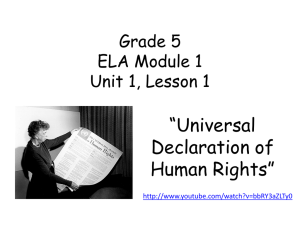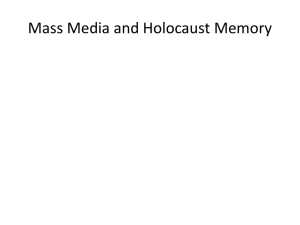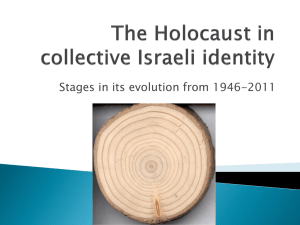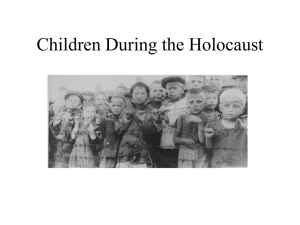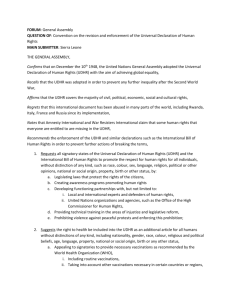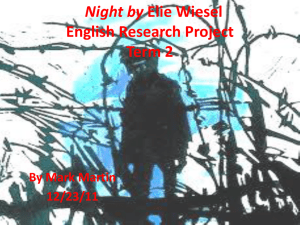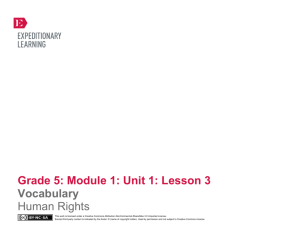SWSH_Feb_2015_Assessing_Historical_Thinking
advertisement
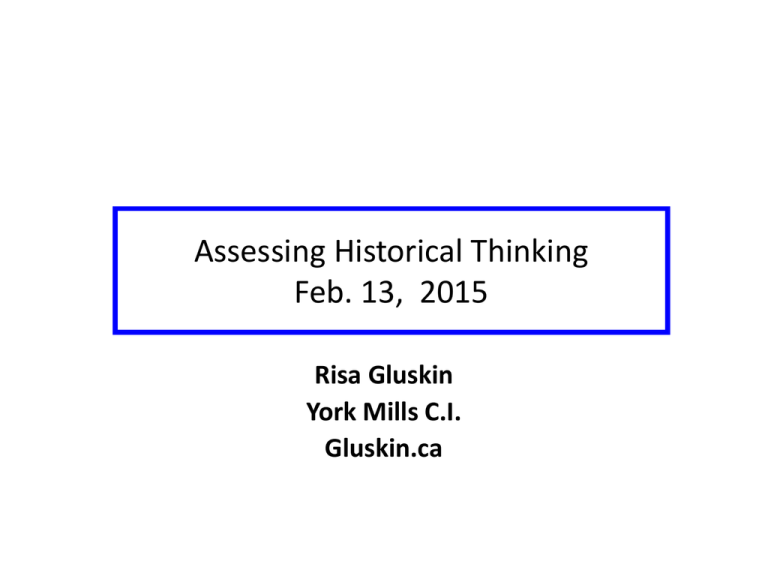
Assessing Historical Thinking Feb. 13, 2015 Risa Gluskin York Mills C.I. Gluskin.ca Less Is More • More emphasis on how we teach • More exploring through an inquiry method • Emphasize why things happened rather than what we teach • Let go of some of the details • Do more with less • Avoid “mile wide, inch deep” disaster Historical Inquiry • Interpretation – Not always looking for the content of the answer but for the skill in the answer As Jill Colyer and Jennifer Watt write in IQ: A Practical Guide to Inquiry Based Learning, a good inquiry question is “an invitation to think (not recall, summarize, or detail).” Inquiry Skills formulating questions gathering and organizing information, evidence, and/or data interpreting and analysing information, evidence, and/or data evaluating information, evidence, and/or data and drawing conclusions communicating findings and/or plans of action Achievement Chart Thinking Application - use of planning skills (e.g., finding appropriate primary sources) - use of processing skills (e.g., interpreting and analysing, detecting point of view and bias in primary sources; formulating conclusions) - use of critical/creative thinking processes (e.g., inferring, using historical thinking) - application of knowledge and skills in familiar contexts (e.g., creating a product such as a poster) - transfer of knowledge and skills to new contexts (e.g., applying historical thinking criteria) - making connections within and between various contexts (e.g., past and present) Holocaust and UDHR Identity, Citizenship, and Heritage: explain how various individuals, groups, and events, including some major international events, contributed to the development of identity, citizenship, and heritage in Canada between 1929 and 1945 (FOCUS ON: Historical Significance; Historical Perspective) C3.3 analyse the impact of the Holocaust on Canadian society and on Canadians’ attitudes towards human rights (e.g., with reference to Canada’s signing of the United Nations Universal Declaration of Human Rights) Causation How did the Holocaust lead to (cause) the writing of the UDHR? How did this influence our view of human rights? UDHR Activity 1. Read each article in the first column and underline key words. In the second column write examples of how the opposite was true during the Holocaust. Then make an argument. UDHR Article Opposite During Holocaust 3. Everyone has the right to life, Example: one million Jews were shot by liberty [freedom] and security Einsatzgruppen (mobile killing squads) after of person [safety]. the Germans invaded the Soviet Union. Argument: Jews did not have the right to life or security because the Nazis wanted them to die. • 2. Conclusion: Let’s look at the cause and consequence relationship between the Holocaust (and WWII) and the writing of the UDHR. – Write a one-paragraph reflection on how the Holocaust led to (caused) the writing of the UDHR? Vocabulary Assist Verbs: • Contributed to • Caused • Led to • Made people think that • Caused people to believe that • Changed people’s beliefs about Nouns: • Discrimination against • Persecution • Murders • Killing of • Treatment of • Problems • Solutions • Rights • Freedoms My Findings Through Assessment as Learning of Written Work Strengths • They identified the causal relationship and were able to explain it using good examples Weaknesses • They had a hard time completing the worksheet correctly Should I have moved on? 1920s Progress and Decline Histiograph • Social, Economic, and Political Context: describe some key social, economic, and political events, trends, and developments between 1914 and 1929, and assess their significance for different groups in Canada (FOCUS ON: Historical Significance; Historical Perspective) • B1.2 identify some major developments in science and/or technology during this period, and assess their significance for different groups in Canada (e.g., the impact of: developments in transportation and communication, such as those related to cars, radios, or motion pictures, on the recreational activities of some Canadians) Timeline Activity • In a group of 5, choose 5 events and/or developments from the 1920s • 2 must represent progress, 2 must represent decline • Find an image to match each one and write a brief, descriptive caption • Individually, write a one paragraph conclusion that sums up the nature of change in the 1920s. How roaring were the 1920s? Base your answer on your group’s choices, but answer individually. Make sure to refer to progress and decline. Rubric Achievement Category Level 4 Level 1 Application Conclusion clearly recognizes that the twenties were either roaring or not depending on the group of people. Sophisticated and deep analysis. Uses historical thinking. Conclusion about the twenties is overly simple and just repeats facts. Applying historical thinking (progress and decline) in written conclusion. Dragon’s Den Assessment As and For Learning • Assessment comes from the Latin word assidere, which means “to sit beside or with” (Lorna Earl, Assessment as Learning, 2003) • Self-assessment to create self-awareness – At beginning of course especially • To create a baseline and set goals – “Overemphasis on the product may devalue the essential experiences of the process of inquiry.” (Jill Colyer and Jennifer Watt, IQ, 2014) Critical Thinking and Criteria • Importance of criteria – Goes well with significance • first guidepost is that significance resulting in change is measured by profundity, quantity and durability of change – Part of critical thinking is avoiding random thinking • Knowing why a decision is made • Having standards – Eventually students can develop their own criteria Dragon’s Den Rubric (for self-assessment) Change Criteria Level 4 Level 1 (or below) When determining historical significance using the resulting in change criterion, student identifies how an event, person, or development resulted in change. Demonstrates thorough understanding of content by giving details that clearly explain how the innovation resulted in change (5 Ws all addressed) Demonstrates limited understanding of content by giving few details; unable to explain how the innovation resulted in change (doesn’t address 5Ws) Applies knowledge in a highly effective manner by directly applying criteria (profundity, quantity, durability) and justifying the innovation as the most significant Applies knowledge with limited effectiveness either with no basis for judgment or personal preference as the basis for historical significance Knowledge When determining historical significance using the resulting in change criterion, student identifies the degree of impact of the change (on how many people, how profoundly, and for how long). Application Learning Skills and Self-Assessment Organization Excellent Needs Improvement identifies, gathers, evaluates, and uses information, technology, and resources to complete tasks Consistently gathers information from reliable sources and uses criteria to assess reliability and relevance Accepts all sources as valid without investigating their reliability or relevance Make It Fun • Ms. or Mr. Continuity or Change • Competitive – crown a winner • In-role Ms. or Mr. Middle Ages Application Criteria Level 4 Level 1 Explains how character / event relates to change or continuity using details and examples Clearly explains how character / event relates to change or continuity with many precise, wellchosen details and examples Barely explains how character / event relates to change or continuity with few details or examples Idle No More • Communities, Conflict, and Cooperation: analyse some significant interactions within and between various communities in Canada, and between Canada and the international community, from 1982 to the present, and how key issues and developments have affected these interactions (FOCUS ON: Continuity and Change; Historical Perspective) • E2.1 describe some significant ways in which Canadians have cooperated and/or come into conflict with each other since 1982 (e.g., the Idle No More movement) Idle No More Tasks Identify different historical perspectives in three different types of evidence: 1. video (views on the Indian Act from The Eighth Fire) • 2. primary source evidence (Indian Act terminology) • 3. Worksheet on how irritating, repressive, and/or absurd aspects of it can be E.g., illegitimates, half-breeds, non-treaty Indian, intoxicants secondary sources (headlines from different newspapers about Idle No More protests) – – The decent fix for aboriginal rights (Maclean’s, Feb. 1, 2013) Idle threats aren’t the answer (Toronto Sun, Jan. 16, 2013). – – – worthwhile movement to gain rights inconvenient dangerous Then, • Students will apply what they’ve learned in an outline of a paragraph (written peer assessment) • Finally they will do a unit culminating activity (assessment of learning) in which they each have to create a poster in the style of the Historical Thinking Project posters and write an argumentative paragraph justifying their choice of image to match the historical thinking concept they chose Success Criteria Level 4 Descriptors – – – – – – – – Clear Accurate Consistent Precise Deep, sophisticated Thorough Detailed Interpretation supported, justified – – – – – – Complex Logical Relevant Plausible Persuasive Analytical vs. descriptive or summary – Creative – Based on criteria


